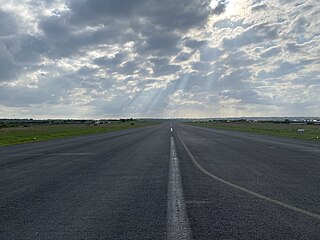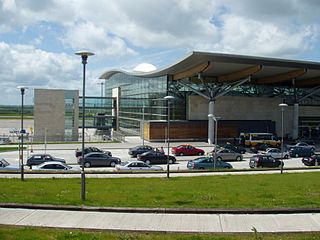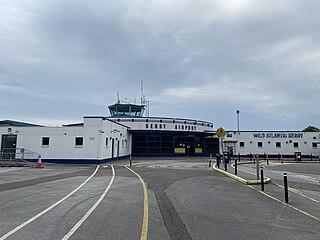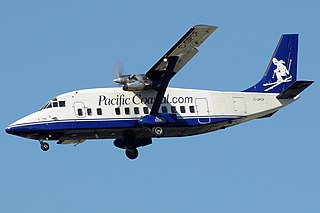
Aer Lingus is the flag carrier of Ireland. Founded by the Irish Government, it was privatised between 2006 and 2015 and it is now a wholly owned subsidiary of International Airlines Group (IAG). The airline's head office is on the grounds of Dublin Airport in Cloghran, County Dublin.

Shannon Airport is an international airport located in County Clare in Ireland. It is adjacent to the Shannon Estuary and lies halfway between Ennis and Limerick. With almost 2 million passengers in 2023, the airport is the third busiest airport in the Republic of Ireland, and the fifth busiest on the island.

Galway Airport is an airport located at Carnmore, 4 NM east of Galway City, County Galway, Ireland, managed by Corrib Airport Limited. Its last scheduled passenger traffic was on 31 October 2011, when Aer Arann ceased commercial operations at the airport. At 1289 m (4230 ft), the runway is too short to handle most jet airliners and so scheduled services were restricted to turboprop aircraft or small executive jets. At peak, the airport served over 300,000 passengers annually, with 16 destinations.

Ryanair is an Irish ultra low-cost airline group headquartered in Swords, Dublin, Ireland. The parent company Ryanair Holdings plc includes subsidiaries Ryanair DACTooltip Designated activity company, Malta Air, Buzz, Lauda Europe and Ryanair UK. Ryanair DAC, the oldest airline of the group, was founded in 1984. Ryanair Holdings was established in 1996 as a holding company for Ryanair with the two companies having the same board of directors and executive officers. In 2019, the transition began from the airline Ryanair and its subsidiaries into separate sister airlines under the holding company. Later in 2019, Malta Air joined Ryanair Holdings.

Bradley International Airport – historically known as Bradley Field – is a public international airport in Windsor Locks, Connecticut, United States. Owned and operated by the Connecticut Airport Authority (CAA), it is the second-largest airport in New England.

Dublin Airport is an international airport serving Dublin, Ireland. It is operated by DAA. The airport is located in Collinstown, 7 km (4.3 mi) north of Dublin, and 3 km (1.9 mi) south of the town of Swords. In 2019, 32.9 million passengers passed through the airport, making it the airport's busiest year on record. It is the 13th busiest airport in Europe, and is the busiest of Ireland's airports by total passenger traffic; it also has the largest traffic levels on the island of Ireland, followed by Belfast International Airport.

Cork Airport is the second-largest international airport in Ireland, after Dublin and ahead of Shannon. It is 6.5 km (4.0 mi) south of Cork City centre, in an area known as Farmers Cross. In 2018, Cork Airport handled 2.39 million passengers, growing by over 8% to 2.58 million in 2019. Following a decline during the COVID-19 global pandemic, which saw passenger numbers fall to 530,000 in 2020, numbers in 2022 rose to 2.24 million.

East Midlands Airport is an international airport in Castle Donington, North West Leicestershire, England. The airport is situated between Loughborough, Derby and Nottingham ; Leicester is 20 miles (32 km) to the south and Lincoln 43 miles (69 km) northeast. It serves the majority of the East Midlands region consisting of the counties of Leicestershire, Nottinghamshire, Southern Lincolnshire, Rutland and Derbyshire. The airfield was originally built as a Royal Air Force station known as RAF Castle Donington in 1943, before being redeveloped as a civilian airport in 1965.
Loganair is a Scottish regional airline headquartered at Glasgow Airport in Paisley, Renfrewshire, Scotland. The airline primarily operates domestic flights within the United Kingdom. It is the largest regional airline in Scotland by passenger numbers and fleet size.

Kerry Airport, often called Farranfore Airport, is an international airport in Farranfore, County Kerry, Ireland. It is 7 nautical miles north off the Ring of Kerry and 8 nautical miles southeast of the county town, Tralee. Passenger services are operated by Ryanair and more recently French airline Chalair. In 2022, Kerry Airport handled 355,043 passengers; a decrease of 4% since 2019.

Aer Lingus Flight 712 crashed en route from Cork to London on 24 March 1968, killing all 61 passengers and crew. The aircraft, a Vickers Viscount 803 named St. Phelim, crashed into the sea off Tuskar Rock, County Wexford. Although the investigation into the crash lasted two years, a cause was never determined. Causes proposed in several investigative reports include possible impact with birds, a missile or target drone, or mechanical and structural failures.

The Short 360 is a commuter aircraft that was built by UK manufacturer Short Brothers during the 1980s. The Short 360 seats up to 39 passengers and was introduced into service in November 1982. It is a larger version of the Short 330.

Le Touquet–Elizabeth II Airport is 2.9 kilometres (1.8 mi) east-southeast of Le Touquet, a commune of the Pas-de-Calais department on the coast of northern France.

Aer Lingus Regional is an Aer Lingus brand which is used for commuter and regional flights. Aer Lingus Regional scheduled passenger services operate primarily from Ireland to the United Kingdom, France, and the Channel Islands, along with services from Belfast, Northern Ireland to the places mentioned. Services were operated by Aer Arann and then its successor Stobart Air until the latter's closure in June 2021. The contract for the franchise was then awarded to Emerald Airlines and services resumed on February 26, 2022.
Stobart Air was an Irish regional airline based in Dublin, originating in 1970 and closing in 2021. It operated scheduled services under the brands Aer Lingus Regional, BA CityFlyer and KLM Cityhopper on behalf of their respective owners. Stobart Air had operating bases in Cork, Dublin and Belfast for Aer Lingus Regional.

Aeroflot Flight 1036 was a domestic scheduled passenger flight operated by Aeroflot, that crashed during takeoff from Sochi International Airport on 1 October 1972. All 109 people aboard the Ilyushin Il-18V perished in the crash. It is the second worst accident involving an Ilyushin Il-18 and it was the worst accident involving one at the time.

Loganair Flight 670A (LC670A) was a scheduled cargo flight for the Royal Mail from Edinburgh-Turnhouse Airport, Scotland to Belfast International Airport. On 27 February 2001 the Short 360 operating the flight ditched then crashed in the Firth of Forth off Edinburgh at around 17:30 local time; the two crewmembers' bodies were found in the wreckage a few hours after the accident.















